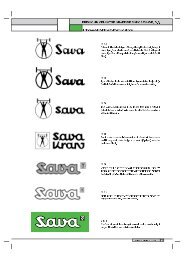Annual report 2005 - Sava dd
Annual report 2005 - Sava dd
Annual report 2005 - Sava dd
Create successful ePaper yourself
Turn your PDF publications into a flip-book with our unique Google optimized e-Paper software.
| notes to the financial statements of the company <strong>Sava</strong> d.d. in accordance with SAS |<br />
1 9 7 |<br />
The depreciation rates are based on the service life of the assets and amount to:<br />
Financial investments<br />
Long-term investments<br />
A long-term investment in capital, proprietary securities<br />
of other companies or debtor’s securities of other<br />
companies or the state are initially recognised at the cost<br />
of purchase, which equals either the paid sum of money<br />
or its equivalents, or the fair value of other substitutions<br />
for a purchase invested by the investor on the exchange<br />
day increased by costs that can be attributed directly to<br />
the investment.<br />
Long-term financial investments in capital of<br />
subsidiaries and associates are valued so as to be<br />
annually increased by that share of the net profit of<br />
subsidiaries or associates, which belongs to the holding<br />
company. Recording shares in profit of associates and<br />
subsidiaries increase the equity revaluation adjustment<br />
in connection with long-term financial investments.<br />
The subsequently received shares in profit decrease the<br />
originally shown increase in financial investment on the<br />
basis of a share in profit.<br />
Long-term investments in companies that are not<br />
investments in subsidiaries or associates are valued in<br />
the financial statements according to the investment<br />
method and are annually not increased by a share of the<br />
net profit that belongs to them. The allocated stakes in<br />
the profit are dealt with outside the investments and<br />
increase the financial revenues.<br />
Long-term investments, which are relocated under<br />
short-term investments, are transferred individually at<br />
their book value.<br />
Short-term investments<br />
Short-term investments in the proprietary securities<br />
of other companies and debtor’s securities of<br />
year <strong>2005</strong> - in % year 2004 - in %<br />
Intangible long-term fixed assets 20.0 20.0<br />
Buildings from 2.5 to 4.0 from 2.5 to 4.0<br />
Plant and machinery from 5.0 do 33.3 from 5.0 to 33.3<br />
Other equipment from 10.0 do 25.0 from 10.0 to 25.0<br />
companies or the state are initially valued at their<br />
purchase value.<br />
At the end of the year the value of those securities,<br />
which are listed on the Stock Exchange, is compared<br />
with the market price on the last day of the accounting<br />
period. In case that the market price is higher than the<br />
average purchase price the increase in value of the<br />
investment is not carried out. If the market price is lower<br />
than the average purchase price, then a revaluation<br />
adjustment is formed for the investment.<br />
For short-term securities, which are not listed on the<br />
Stock Exchange, the actual value is determined on the<br />
basis of last known transactions.<br />
Receivables<br />
At their initial recognition the receivables of all types are<br />
shown in the amounts that arise from the corresponding<br />
documents on condition that they will be paid. The<br />
original receivables can later be increased, or irrespective<br />
of payment or any other settlement, decreased by every<br />
amount, which is proven by an agreement.<br />
The advances in the balance sheet are shown in relation<br />
with things they are refer to.<br />
Receivables, which are assumed not be settled within<br />
the due term and in total amount respectively, are<br />
considered doubtful and, if a court procedure has<br />
already began, disputable.<br />
The revaluation adjustments in receivables are formed<br />
as follows:<br />
• a 100 per cent adjustment in all sued receivables and<br />
receivables filed in a bankruptcy proceeding, as well<br />
as current receivables, if the responsible service makes








